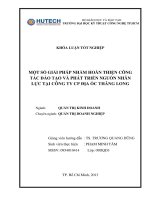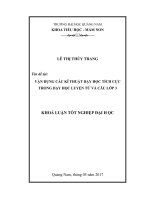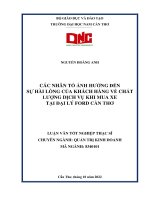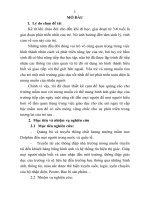FUNDAMENTAL CHEMISTRY II - Full 10 điểm
Bạn đang xem bản rút gọn của tài liệu. Xem và tải ngay bản đầy đủ của tài liệu tại đây (429.15 KB, 84 trang )
3.2 ĐỀ CƯƠNG TIẾNG ANH
3.2.1) Các môn thuộc khối kiến thức đại cương
1) TN101: Fundamental Chemistry I
1
Title:
TN101: Fundamental Chemistry I
2 Number of Credits: 3
3 Instructors
Dr. Bui Thi Buu Hue
4 Distribution of Time
Workload:
Lectures:
3 lecture hours * 15 weeks = 45 lecture hours
Self-Study: 2 lecture hours * 15 weeks = 30 lecture hours
5 Prerequisites: Open for all students having the high school courses on chemistry,
mathematics, physics and informatics
6 Course Objectives
The major purpose of this course is to provide core topics that are necessary for a good
foundation in general chemistry.
7 General Course Contents
The course will focus on the following subjects:
• Atomic structure and the periodic table
• Chemical bond and molecular structure
• Chemistry of the representative elements, transition metals and complex compounds.
• Introduction of Kinetic Chemistry
• Thermal Chemistry
• Chemical Equilibrium
• Solution
• Electrochemistry
8 Required Responsibility for Student
- Lecture/Class attendance: students must attendant at least 80% of lectures
- Mid-term Test: students must take mid-term test
- Final Examination: students must take final exam
9 Reading Materials
a) Steve S. Zumdahl, 1993, Chemistry, 3th Ed. DC. Heath & Company. Lexington, MA.
b) R. Chang, 1996, Essential Chemistry, McGraw-Hill, Inc.
c) Jean B. Umland, 1993, General Chemistry, West Publishing Company.
d) Bùi Thị Bửu H, 2004, Giáo trình Hóa Đại Cương A1, Khoa Học.
10 Criteria of Evaluation
The final examination will be conducted at the end of the course. The final course grade is
determined by the sum of the points obtained by the mid-term test and final examination.
11 Grading System
- Mid-term test: 30%
- Final Exam: 70%
- 85 -
12 Detail Description of Course
Atomic structure and the periodic table
a) The modern view of atomic structure
b) Quantum mechanics and atomic theory
c) Periodic law and the periodic table
Chemical bond and molecular structure
a) Molecule and chemical bonds
b) Ionic bonding
c) Covalent Bonding
d) Intermolecular forces
e) V. Metallic bonding
The representative elements: Group 1A through 4A
a) The group IA elements
b) Hydrogen
c) The group IIA elements
d) The group IIIA elements
e) The group IVA elements
The representative elements: Group 5A through 8A
a) The group VA elements. Chemistry of nitrogen and phosphorus
b) The group VIA elements. Chemistry of oxygen and sulfur
c) Environmental chemistry. Group VIIA
d) Chemistry of the group VIIA and VIIIA elements
Transition metals and the chemistry of complex compounds
a) The transition metals: a survey
b) Coordination compounds: nonmenclature, structure, isomerism
c) Bonding in complex ions: the localized electron model, the crystal field model.
d) The biologic importance of coordination compounds
Thermodynamics
a) Introduction
b) The first law of thermodynamics: Entalpy
c) The second laws of thermodynamics: entropy and free energy
Chemistry Kinetics
a) Rates of Reations
b) Rate laws
c) Factors affect the reaction rate
d) Catalyst
Chemical Equilibrium
a) Introduction to Chemical Equilibria
b) Equilibrium Constants and Equilibrium Constant Expressions
- 86 -
c) Le Chatelier’s Principle
Solution
a) Introduction to dispersing systems
b) Types of solution concentration
c) Colligative properties
d) Acid-Base
e) Solubility Equilibria
Oxidation-Reduction Reations and Electrochemistry
a) Oxidation-Reduction Reations
b) Voltaic Cells
c) Electrolytic Cells
- 87 -
2) TN102: Fundamental Chemistry I Laboratoy
1
Title:
TN102: Fundamental Chemistry 1 Lab
2 Number of Credits: 1
3 Instructors
Dr. Bui Thi Buu Hue
4 Distribution of Time
Workload: Laboratory: 5 lecture hours * 6 weeks = 30 lecture hours
5 Prerequisites: Fundamental Chemistry 1
6 Course Objectives
To illustrate basic knowledge on general chemistry including chemical equilibrium,
thermodynamics, chemical kinetics, acid-base and inorganic chemistry.
7 General Course Contents
The course will provide students with experiments focusing on the chemical equilibrium
in solution, enthalpy change associating with a chemical reaction, reaction rate, chemistry
of non-metals and their compounds and chemistry of transition metals and complex
compounds.
8 Required Responsibility for Student
Students are required to attent all the experimental hours of the course and write complete
reports.
9 Reading Materials
a) Mai Viet Sanh, 1997, Giao trình thực tập Hóa Đại Cương A2, Khoa Khoa Học.
b) Mai Viết Sanh, 1997, Giáo trình Thực tập Hóa Vơ cơ và Hữu cơ Đại cương A3, Khoa
Khoa Học.
10 Criteria of Evaluation
The final examination will be conducted at the end of the course. The final course grade is
determined by the sum of the points obtained by the final examination and the complete
reports.
11 Grading System
Report:
30%
Oral exam: 70%
12 Detail Description of Course
Solubility Equilibria
Calorimeter
Chemical equilibrium
Reaction rate
Chemistry of non-metals and their compounds
Chemistry of transition metals and coordination compounds
- 88 -
3)
TN103: Fundamental Chemistry II
1
2
3
4
5
6
Course Title:
TN103: Fundamental Chemistry II
Number of Credits: 2
Instructor
Dr. Le Thanh Phuoc
Distribution of Time
Workload:
Lectures:
3 lecture hours * 10 weeks = 30 lecture hours
Private Study:
3 lecture hours * 10 weeks = 30 lecture hours
Prerequisites:
Fundamental Chemistry II
Course Objectives
This course aims to supply the student with:
a) most basic knowledge about organic compounds their physical, chemical
properties, nomenclature and preparations.
b) overview about isomers and chiral in organic chemistry
c) concept of structure, solubilities, and acid-base properties of organic substances
7
General Course Contents
a) Some general characteristics of organic molecules
b) Chemistry of hydrocarbons
c) Chemistry of functional Groups: Alcohols and Ethers.
d) Componds with a carbonyl group
e) Introductions to Biochemistry, Proteins, Carbohydrates, Nucleic Acids.
8
Required Responsibility for Student
- Lecture/Class attendance: 80% (or 24 hrs) of lectures
- Lab. Attendance:
- Mini Projects/Assignment:
- Discussion and/or Seminar:
- Mid-term Test: 30%
- Final Examination: 70%
Reading Materials
a) Do Thi My Linh, 2000, Organic Chemsitry Lecture Notes,, Cantho University
b) Brown, Lemay, and Bursten, 2003, Chemistry: the Central Science, 9th edition,
Pearson-Prentice-Hall
c) Seyhan N. Ege, 1999, Organic chemistry, Structure and reactivity, 4th edition.
Houghton Mifflin Company .
9
10
11
12
Criteria of Evaluation
Homework Assignments and Final Examination
Grading System
- Homework Assignments: 30%
- Final Exam: 70%
Detail Description of Course
- 89 -
a)
b)
-
Some general characteristics of organic molecules
The structures of organic molecules
The stabilities of organic substances
Solubilities and acid-base properties of organic substances
Introductions to hydrocarbons: Alkanes
Structures of alkanes
Structural isomers
Nomenclatures of alkanes
Cycloalkanes
Reactions of alkanes
c)
-
Unsaturated hydrocarbons
Alkenes
Alkynes
Addition reactions of alkenes and alkynes
Mechanism of addition reactions
Aromatic hydrocarbons
d) Functional Groups: Alcohols and Ethers
- Alcohols
- Ethers
e)
-
Componds with a carbonyl group
Aldehydes and ketones
Carboxylic acids
Amines and amides
f)
-
Stereochemistry - Chiral in organic chemistry
Chirality
R and S nomenclature of asymmetric carbon atoms
Fischer projections
Diastereomers and meso compounds
g)
-
Introductions to Biochemistry: Proteins
Amino acids
Polypeptides and Proteins
Protein structure
h) Carbohydrates
- Monosaccharides and disaccharides
- Polysaccharides
i) Nucleic Acids
- Ribonucleosides and ribonucleotides
- Deoxyribose and the structure of deoxyribonucleic acid
- 90 -
4) TN104: Fundamental Chemistry II Laboratoy
1
2
3
4
5
6
7
8
Title:
TN104: Fundamental Chemistry II Lab.
Number of Credits: 1
Instructor:
Dr. Le Thanh Phuoc
Distribution of Time
Workload:
Laboratory: 5 lecture hours * 6 weeks = 30 lecture hours
Prerequisites: General chemistry laboratory I
Course Objectives
This course aims to supply the student with:
a) Most basic knowledge about organic laboratory techniques
b) The normal scale as well as microscale techniques used in organic chemistry
laboratory to determine of functional groups and will perform a few synthetic
experiments.
c) Measuring methods of Melting Points, Boiling Points and recrystalization of the
prepared products.
General Course Contents
a) Qualitative analysis of organic compounds
b) Sulfonation, esterification and aldol condensation
c) Chemsitry of nonmetals and their compounds
d) Chemsitry of transition metals
Required Responsibility for Student
- Lab. Attendance: 100% of experiments
- Discussion: 100%
- Final Examination: requisite
9
Reading Materials
1. Kenneth L. Williamson, 1994. Macroscale and Microscale Organic Experiments,
Second Edition, Mount Holyoke College.
2. Arthur I, 1989. Volgel's texbook of practical organic chemistry, 5th ed., Prentice Hall.
3. Phan Tống Sơn, Lê Đăng Danh, 1977. Thực tập hóa học hữu cơ- tập 1,2, NXB
Khoa học và Kỹ thuật Hà Nội .
4. Ngô Thị Thuận, 1999. Thực tập hóa học hữu cơ, NXB Đại Học Quốc Gia Hà Nội.
11
Grading System
- Lab reports: 30%
- Oral. Exam: 70%
Detail Description of Course
a) Qualitative analysis of organic compounds
b) Sulfonation reaction: Preparation of natri p-toluene sunfonat
c) Esterification reaction: Preparation of Aspirin and ethyl acetate
d) Aldol condensation: Preparation of benzal acetophenon
e) Chemsitry of nonmetals and their compounds
f) Chemsitry of transition metals
12
- 91 -
5) TN105/TN106: Analytical Chemistry
1
2
3
4
5
6
Title:
TN105/TN106: Analytical Chemistry
Number of Credits: 2
Instructor
Msc. Phan Thanh Chung
Distribution of Time
Workload:
Lectures:
2 lecture hours * 15 weeks = 30 lecture hours
Private Study:
2 lecture hours * 15 weeks = 30 lecture hours
Prerequisites: Foundation Chemistry I and II
Course Objectives
The major objective of this course is to provide a basic theory for studying chemical
equilibrium and calculating concentrations of components and other relative quantities
in electrolytic solutions. The knowledge of this course is the theoretical basis of other
subjects included or related to analytical chemistry.
7
General Course Contents
a) Acid/Base Equilibrium – Neutralization Titrations
b) Complex- Formation Equilibrium – Complex-Formation Titrations
c) Oxidation/Reduction Equilibrium - Oxidation/Reduction Titrations
d) Pricipitation Equilibrium – Precipitation Titrations
8
Required Responsibility for Student
- Lecture/Class attendance: Not mandatory
- Exercises: Self-study
- Mid-term Test: 100% attendance
- Final Examination: 100% attendance
Reading Materials
9
a)
b)
c)
d)
Hoàng Minh Châu, Từ Văn Mạc, Từ Vọng Nghi (2007). Cơ sở Hóa học phân tích,
Nhà xuất bản Khoa học Kỹ thuật.
Phan Thành Chung (1999). Bài giảng hóa phân tích, Đại học Cần thơ.
Douglas. A. Skoog, Donal M. West, F. James Holler (1992). Fundamentals of Analytical
Chemistry. Saunder College Publishing.
e) Nguyễn Tinh Dung (1981). Hóa học phân tích. Nhà xuất bản Giáo dục, Hà nội.
11
12
Grading System
- Midterm Exam: 30%
- Final Exam: 70%
Detail Description of Course
a) An Introduction to Analytical Chemistry
- Solution.
- Concentration
- Chemical Laws
- Method of ionic equilibrium calculation.
b) Acid/Base Equilibrium
- 92 -
-
Theory
- Bronsted – Lowry’s Theory
- Monofunctional Acid/Base Solutions
- Polyfunctional Acid/Base Solutions
- Salt Solutions
- Buffer Solutions
- Multiple Charged Ion Solutions
-
Acid/Base Titrations
- Principle
- Acid/Base Indicators
- Titration of a Strong Acid with a Strong Base
b) Complex- Formation Equilibrium
- Theory
- Introduction to Complex
- Stability and Instability Constants of Complex.
- Equilibrium Concentrations in Complex-Formation Solution
- Effects of pH and Other Complexing Agents on Complex-Formation Equilibrium
- Complex-Formation With Organic Reagents
-
-
Complex-Formation Titrations
- Complexons
- Effects of the Medium
- Indicators for EDTA Titrations
- EDTA Titration Curves
c) Oxidation/Reduction Equilibrium
- Theory
- Introduction to Oxidation/Reduction Reaction
- Formation of Oxidation/Reduction Reaction with Ion-Electron Balance Method
- Oxidation/Reduction Potential
- Potential of the Mixture of an Oxidant and a Conjugate Reductant
- Equilibrium Potential of a Mixture of an Oxidant and a Reductant
- Equilibrium Constant for Oxidation/Reduction Reaction
-
Oxidation/Reduction Titrations
- Introduction to Redox Titrations
- Methods of Redox Titrations
- Indicators for Redox Titrations
- Redox Titration Curves
d) Precipitation Equilibrium
- Theory
- Solubility Product Constant and Solubility
- Factors Effect on Solubility
- 93 -
-
Co- Precipitation
Precipitate Dissolve
Precipitation Titrations
- Principle
- Precipitation Titrations with Silver Nitrate
- Argentometric Methods – Mohr’s Method
- Gravimetric Method
- 94 -
6) TN107 (BIOL1020): Principles of Biology
1
2
3
4
5
6
7
Title:
TN107 (BIOL 1020): Principles of Biology
Number of Credits: 2
Instructors:
Mr. Bui Tan Anh
Distribution of Time
Workload:
Lectures:
3 lecture hours * 10 weeks = 30 lecture hours
Private Study:
2 lecture hours * 15 weeks = 30 lecture hours
Prerequisites: none
Course Objectives
This course will acquaint students with the key cellular and subcellular processes
underlying the activity of living systems. Topics include the structure, function, and
synthesis of macromolecules, the cellular conversion and use of energy, the replication,
transmission, and expression of genetic information.
The primary goals of the course are: 1) to provide students with an appreciation for both
the order and complexity inherent in cellular function and 2) to prepare students for more
advanced coursework and/or self-directed study in biology and biotechnology.
General Course Contents
a) Macromolecule synthesis
b) Structure and Function of the Cell
c) Energy metabolism
d) Principles of genetics
8
Required Responsibility for Student
a) Lecture/Class attendance: not allow to absent more than 20% of lectures
b) Lab. Attendance: Mandatory
c) Discussions: Mandatory
9
Reading Materials
a) Campbell, N.A, J. B. Reece, E.J. Simon 2004. Essential Biology. 2nd Ed. The
Benjamin/Cummings Pub. Com., Inc. CA.
b) Campbell, N.A, J. B. Reece 2004. Biology. 7th Ed. The Benjamin / Cummings Pub.
Com., Inc. CA.
c) Freeman, S. 2005. Biological Science 2nd Ed. Pearson Education Inc.
d) 4. Purves, W. K., D. Sadava, G. H. Orians, H. C. Heller, 2003. Life, The Science of
Biology, 7th Ed. Sinauer Associates and W. H. Freeman.
10 Criteria of Evaluation
Missed lecture or discussion will be lost 0,5 point
11 Grading System
- Midterm exam: 30 %
- Final Exam:
70 %
12 Detail Description of Course
- 95 -
Structure and Function of Macromolecules
a) Polymer Principles
b) Carbohydrates-Fuel and Building Material
c) Lipids-Diverse Hydrophobic Molecules
d) Proteins-The Molecular Tool of the Cell
e) Nucleic Acids-Informational Polymers
Cell structure and Function
a) An Overview
b) Structure of Eucaryotic Cell
c) Structure od Procaryotic Cell
Membrane Structure and Function
a) Membrane structure
b) Traffic Across Membranes
- 2.1. Passive Transport
- 2.2. Active Transport
c) Exocytosis and Endocytosis
Cellular Respiration
a) Principles of Energy Harvest
b) Aerobic Cellular Respiration
c) Anaerobic Cellular Respiration
d) Metabolic Processing of Lipid and Protein
Photosynthesis
a) The Logic of Leaf Design
b) The light reaction
c) The dark reactions – Calvin cycle
d) C4 and CAM Photosynthesis
The Cell Cycle
a) Structure and Function of Chromosome
b) The Mitotic Cell Cycle
c) Meiosis and Sexual Life Cycles
The Molecular Basic of Inheritance
a) DNA as the Genetic Material
b) Nucleic Acids Structure
c) DNA Replication and Repair
Protein Biosynthesis
a) The Connection Between Genes and Proteins
b) The Synthesis and Processing of RNA- Transcription
c) The Synthesis of Protein- Translation
d) Regulation of Gene expression
- 96 -
DNA Technology
a) Recombinant DNA
b) Electrophoresis
c) The Polymerase Chain Reaction
d) Application of DNA Technology
- 97 -
7) TN108: Principles of Biology Laboratory
1
Title:
TN108: Priciples of Biology Laboratory
2 Number of Credits: 1
3 Instructor
MSc. Bui Tan Anh
4 Distribution of Time
Workload:
5 lecture hours * 6 weeks = 30 lecture hours
5 Prerequisites: Principles of Biology
6 Course Objectives
This course provides some basic skills in General Biology. The experiments being related
to main concepts studied in Principles of Biology..
7 General Course Contents
The Microscope
Cell Structure
Enzyme Activities
Cell Division
Chromosome morphology
8 Required Responsibility for Student
- Lab. Attendance is mandatory
- Doing practical report
9 Reading Materials
a) P. Abramoff, R. G. Thomson, 1994, Laboratory Outlines in Biology VI. W.H.
Freeman & Co. New York.
b) S. E. Gunstream, 2001, Biological Exploration, 4th ed. Pearson Prentice Hall.
10 Criteria of Evaluation
Missed labworks will be not allowed to take the final exam.
11 Grading System
- Practical report:
30 %
- Final Exam: 70 %
12 Detail Description of Course
The microscope
Animal and Plant Cell
Starch Hydrolysis By Amylases
Mitosis
Meiosis
Salivary Gland Chromosomes in Drosophila
- 98 -
8) TN109 (MATH 1610): Advanced Mathematics
1
2
3
4
5
6
Course name:
TN109 (MATH 1610): Advanced Mathematics
Number of Credits: 2
Instructor:
Dr. Nguyen Huu Khanh
Distribution of Time
Workload:
Lectures:
3 lecture hours * 10 weeks = 30 lecture hours
Private Study:
3 lecture hours * 10 weeks = 30 lecture hours
Prerequisites:
Mathematics in high school
Course Objectives
This course aims to supply the student with most basic knowledge about Advanced
Mathematics: systems of equations, functions, limits, differentiation, integrals, series,
functions of several variables.
7
General Course Contents
Systems of equations
Functions and limits
Differentiation and integrals
Series and functions of several variables.
8
Required Responsibility for Student
- Class attendance: 100% of experiments
- Assignment / exercise: 100%
- Mid-term exam: requisite
Final Examination: requisite
Tài liệu học tập (ghi 3-4 tài liệu)
a) Barnett and R. Ziegler (1989). Applied Mathematics, Dellen Publishing Company,
1989.
b) Boyce,E. and C. Diprima (1989). Calculus. John Wiley & Son, Inc.
c) Dams, A. (1995). Calculus. Addition-Wesley Publishers Limited, 3rd ed.
d) Goldstein, J., Lay and I. Schneider (2004). Calculus & Its Applications. Pearson
Education, Inc..
e) Thomas, G. and R. Finney. Calculus, Addition-Wesley, 8th, 1992.
f) Nguyễn Đình Trí (1995). Tốn học cao cấp, NXB GD.
g) Phan Quốc Khánh (2000). Phép tính vi phận. NXB GD 2000.
9
11
Grading System
- Assignment/exercise: 20%
- Mid-term Exam: 30%
- Final Exam: 50%
12
Detail Description of Course
a) Systems of linear equations
- 99 -
-
System of linear equations and augmented matrices.
Gauss-Jordan elimination.
Matrices and matrix equations.
b) Functions, Limits, Continuity.
- Real numbers and the real line, intervals, absolute value of real numbers.
- Functions
- Limits
- Continuity
c)
-
Derivatives
Tangent lines and their slopes, the concept and definition of derivative.
Right- and left-hand derivatives.
Differentiability in an interval.
The relation between differentiability and continuity.
Rules for differentiation.
Differentiation of composite functions and inverse functions.
Implicit differentiation.
Derivatives of elementary functions.
Higher order derivatives.
Differentials.
Mean value theorems.
Indeterminate forms and L' Hospital's rule.
Taylor's formula.
Maxima and minima.
Polar coordinates and parametric curves.
Applications: rates of change, optimization problems, linear
approximation problems.
d)
-
Integrals
Indefinite integrals.
Definite integrals.
Improper integrals.
e) Series
- Sequences and series.
- Power series.
f)
-
Functions of several variables.
Neighborhoods, regions, the definition of function, graph of a function.
Limits and continuity.
Partial derivatives, higher order partial derivatives.
Gradient and directional derivatives.
Differentials.
Maxima and minima.
- 100 -
9) AQUA201 (ENGL1100): English for aquaculture I
1
2
3
4
5
6
Title:
AQUA201 (ENGL1100): English for aquaculture I
Number of Credits: 3
Instructors
A/Prof. Dr. Nguyen Anh Tuan and Dr. Vu Ngoc Ut
Distribution of Time
Workload: Lectures:
2 lecture hours * 15 wks = 30 lecture hours
Discussion/seminars:
1 lecture hours * 15 wks = 15 lecture hours
Private Study:
2 lecture hours * 15 wks = 30 lecture hours
Prerequisites: Basic English
Course Objectives
This course aims to introduce students the methodologies to learn aquaculture and
fisheries terms that will be used for reading references, listening lectures, giving talk and
writing assignment and thesis.
7 General Course Contents
a) Introduce learning methodologies for technical terms
b) Review briefly on commonly used grammar in science
c) Introduce reading methodologies for technical papers, books,…
d) Improve speaking skills
8 Required Responsibility for Student
- Lecture/Class attendance: 80% of lectures
- Discussion and/or Seminar: 100%
- Mid-term test: requirement
- Final Examination: requirement
9 Reading Materials
a) Nguyễn Anh Tuấn, Lê Thanh Hùng và Nguyễn Thanh Phương (2005). Giáo trình
tiếng Anh chun ngành Ni trồng Thủy sản. Nhà xuất bản Nông nghiệp.
a) Website of the World Aquaculture Society (www.was.org) – presentation of papers in
various conferences
b) Scientific papers/articles will be supplied during the course
11 Grading System
- Homework Assignments: 15%
- Seminar/Class presentation: 20%
- Mid-term Exam: 15%
- Final Exam: 50%
12 Detail Description of Course
a) Introduction to learning methodologies for technical terms
c) Scope and definition of aquaculture
- Grammar review: noun
- Explanation of important terms
- Comprehensive reading and translating the text
- Supplementary reading article: Important culture species
- 101 -
d)
-
Site selection for aquaculture
Grammar review: Adjectives
Explanation of important terms
Comprehensive reading and translating the text
Supplementary reading article: Typical aquaculture operarions
e)
-
The fish pond environment
Grammar review: Adverbs
Explanation of important terms
Comprehensive reading and translating the text
Supplementary reading article: Free selective
f)
-
Fish-rice systems
Grammar review: Articles
Explanation of important terms
Comprehensive reading and translating the text
Supplementary reading article: Aquatic weed control techniques
g)
-
Nature and source of live food
Grammar review: Prepositions
Explanation of important terms
Comprehensive reading and translating the text
Supplementary reading article: Free elective
h)
-
Culturing the rotifer
Grammar review: Conjunctions
Explanation of important terms
Comprehensive reading and translating the text
Supplementary reading article: Production of microalgae for aquaculture
i)
-
Species combination and polyculture
Grammar review: Infinitive
Explanation of important terms
Comprehensive reading and translating the text
Supplementary reading article: Fee elective
- 102 -
10) AQUA202 (ENGL 1120): English for Aquaculture II
1.
2.
3.
4.
5.
6.
7.
Title:
AQUA202 (ENGL 1120): English for Aquaculture II
Number of Credits: 3 credits
Instructors
A/Prof. Dr. Nguyen Anh Tuan and Dr. Vu Ngoc Ut
Distribution of Time
Workload:
Lectures:
1 lecture hours x 15 wks = 15 lecture hours
Discussion/presentation: 2 lecture hours x 15 wks = 30 lecture hours
Private Study:
2 lecture hours x 15 wks = 30 lecture hours
Prerequisites: Basic English
Course Objectives
This course aims to introduce students methodology to approach aquaculture and fisheries
terminologies that will be used for reading references, listening lectures, giving talk and
writing assignment and thesis.
General Course Contents
e) Introduce learning methods for technical terms/words (complicated words)
f) Review briefly on commonly used grammar in science
g) Introduce reading methods (scanning) for technical papers, books,…
h) Improve presentation skills
8.
Required Responsibility for Student
- Lecture/Class attendance: 80% of lectures
- Discussion and/or Seminar: 100%
- Mid-term Test: complete all tests
- Final Examination: complete
9. Reading Materials
j) Nguyễn Anh Tuấn, Lê Thanh Hùng và Nguyễn Thanh Phương (2005). Giáo trình
tiếng Anh chun ngành Ni trồng Thủy sản. Nhà xuất bản Nông nghiệp.
b) Website of the World Aquaculture Society (www.was.org) – presentation of papers in
various conference
k) Scientific paper/article will be supplied during the course
10. Grading System
- Homework Assignments: 15%
- Seminar/Class presentation: 20%
- Mid-term Exam: 15%
- Final Exam: 50%
11. Detail Description of Course
a) Natural feeding behavior of Tilapia
- Grammar review: Participles
- Explanation of important terms/words
- Comprehensive reading and translating the text
- Writing short notes and presentations
- Supplementary reading article: Scientific names
- 103 -
b)
-
Nutrient requirement of fish
Grammar review: Gerunds
Explanation of important terms
Comprehensive reading and translating the text
Group discusssion
Supplementary reading article: Fish meal and fish oil utilization in aquafeeds
c)
-
Osmoregulation and ion balance in fish
Grammar review: Simple future tense
Explanation of important terms
Comprehensive reading and translating the text
Writing short notes and presentations
Supplementary reading article: Free selective
d)
-
Propagation of Chinese major carps
Grammar review: The present perfect tense
Explanation of important terms
Comprehensive reading and translating the text
Group discusssion
Supplementary reading article: Biology of natural propagation of finfish
e)
-
Introduction to fish genetics
Explanation of important terms
Comprehensive reading and translating the text
Presentation of free selected papers
Supplementary reading article: Free selective
f)
-
Shrimp diseases
Explanation of important terms
Comprehensive reading and translating the text
Writing short notes and presentations
Supplementary reading article: white spot syndrome virus in shrimp
g)
-
Fish diseases
Explanation of important terms
Comprehensive reading and translating the text
Presentation of free selected papers
Supplementary reading article: Free selective
-
- 104 -









